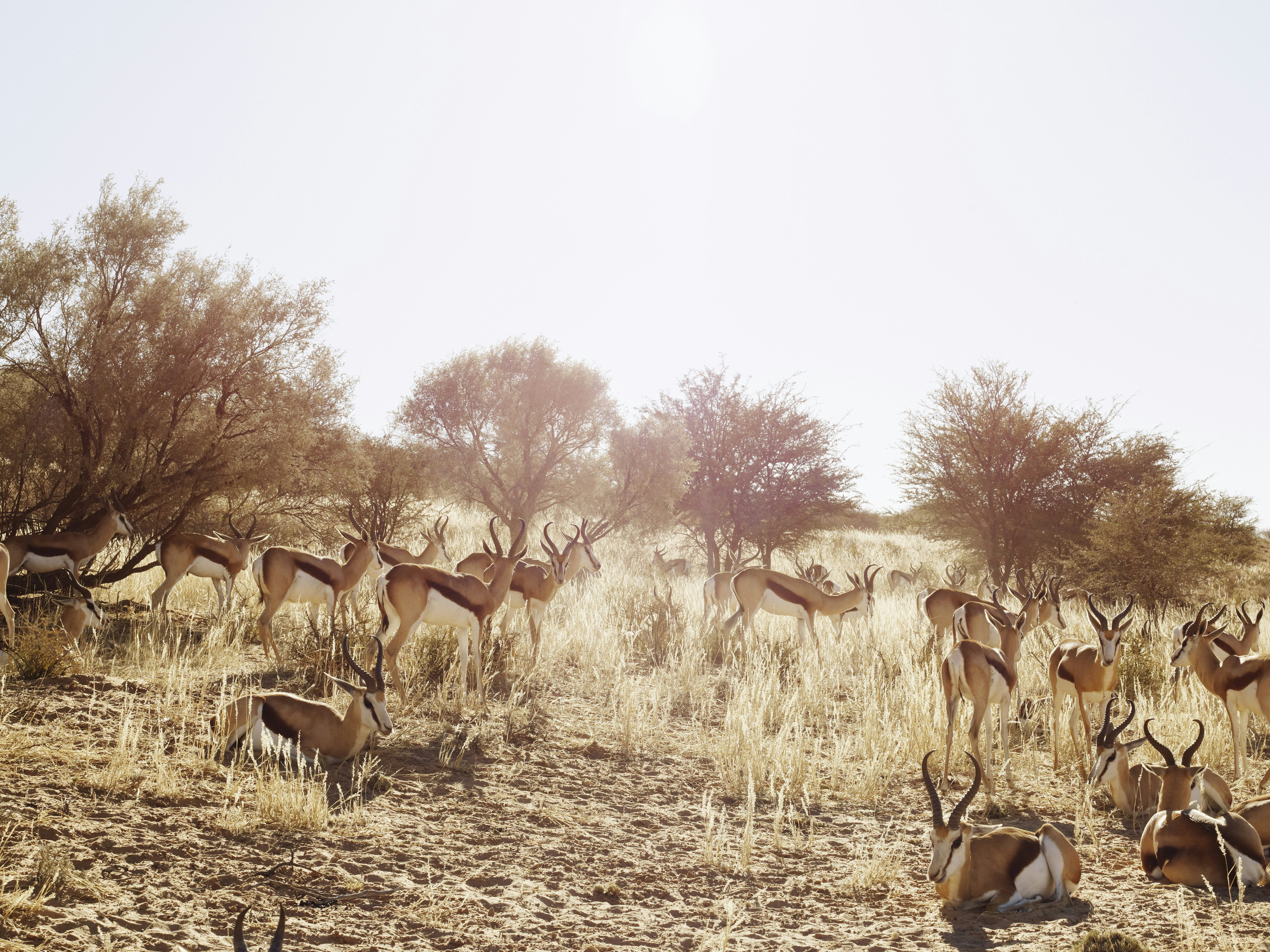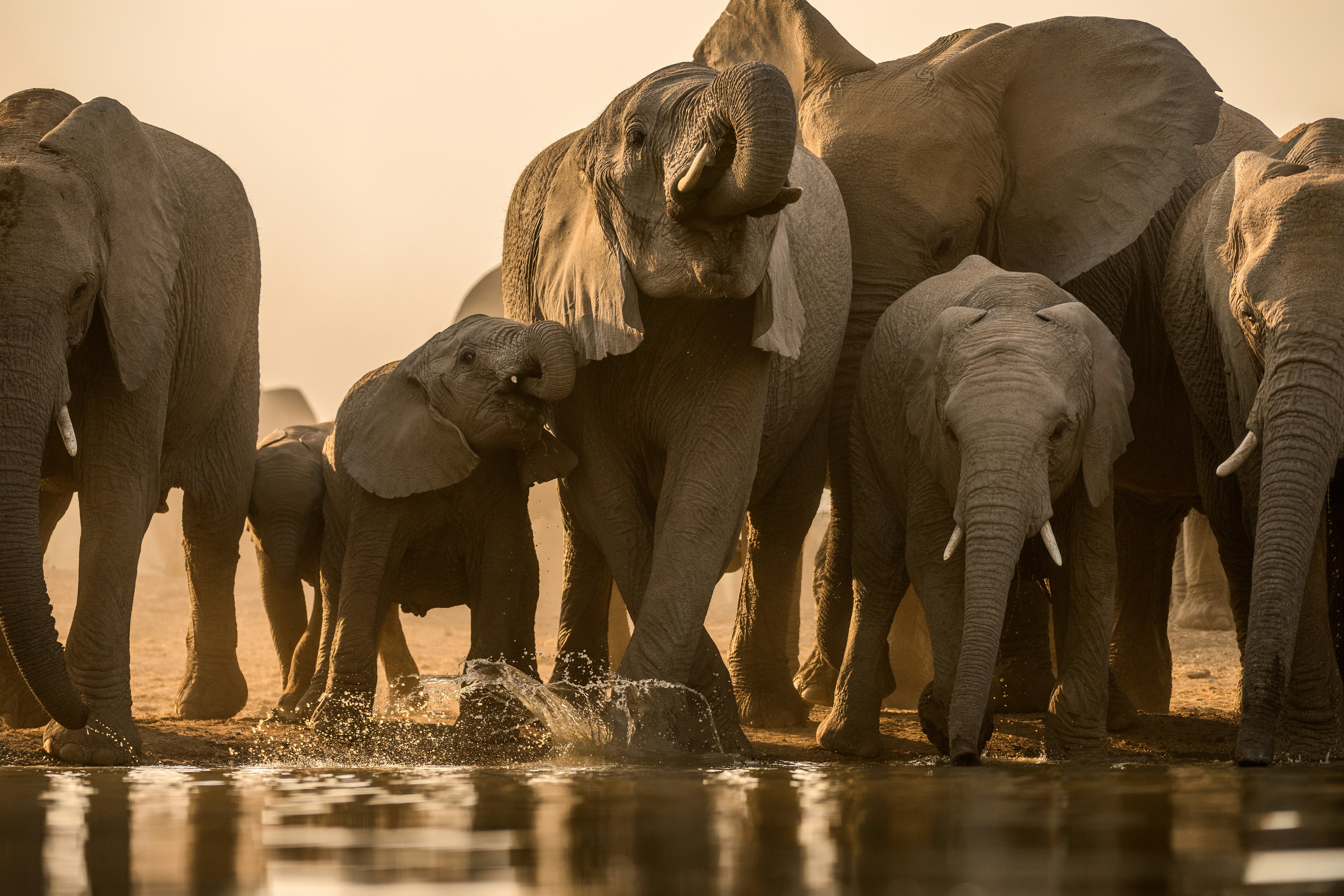

A cheetah hunting in Kgalagadi Transfrontier Park, South Africa. Andre Marais/Shutterstock
A visit to South Africa isn’t complete without spending time in at least one of its world-renowned game reserves. This fascinatingly diverse country has more parks and lodges than you could explore in a decade’s worth of vacations, and planning the perfect safari can feel pretty overwhelming. Where do you even start? We suggest you begin right here.

How much does a safari cost in South Africa?
There are opportunities for travelers of all budgets to connect with South Africa’s wildlife. Destinations range from the country’s national parks (including world-famous Kruger National Park, where camping starts at less than R500/US$28 a site per night) to scores of provincial nature reserves (like the revered Hluhluwe-Imfolozi Park) to private game reserves, where prices tend to be high-end, often upwards of R8000 (US$452) per night (the price usually includes guided game drives, accommodation, meals and most drinks).
Planning tip: If you’re going to spend more than a week (in total) in provincial and/or national parks, buy a Wild Card and save on the daily conservation fees. There are cards for individuals, couples and families.
How much time do I need?
Plan to stay a minimum of three nights, as this will give you time to go on a few game drives as well as chill out and soak up the atmosphere of the African bush. South Africans will tell you that the more time you spend in a park the better; many devote their annual holidays to staying in a park and it’s not unusual, when you’re in a campsite at the enormous Kruger National Park, to meet people who’re spending more than a month there.

When’s the best time to go?
The dry season (May to September) is regarded as the best time for game viewing because the vegetation is not too dense at this time of year, so it’s easier to spot animals. Plus, they often gather at water holes. The green season (October to April) is brilliant for birders as this is when many migratory species have returned; keep in mind that the summer months can be uncomfortably hot in the Kruger region (daytime temperatures regularly reach the high 30°s/low 100°Fs). If you’re wanting to visit a provincial or national park, know that the South African school holidays around Easter and Christmas are popular times for families to visit parks (Kruger especially), so it’s best to book months in advance.
What will I see?
Many first-time visitors to Southern Africa are keen to see the Big Five (lion, leopard, rhino, elephant and buffalo), but don’t get hung up on ticking only these mammals off your list, because the true joy of a safari comes with simply being out in the bush, watching birds and animals interact and learning more about the complex ecosystems that exist. While animal sightings can be unpredictable, there’s a good chance you’ll see plains game like zebra, impala, giraffe and wildebeest, which are common across the country. Depending on the park you might also see cheetah, hippos, hyenas, crocodiles, springbok, oryx and eland, as well as smaller animals like hares, jackals, honey badgers, bat-eared foxes and, if you’re lucky, African wild dogs.

Where should I go?
South Africa has 21 national parks and more than 400 protected areas (including private game reserves), so it’s well worth doing your research. Start by considering what you’re hoping to see and experience.
To tick off the Big Five
If you’re wanting to tick off the Big Five, then Kruger National Park and the neighboring private reserves – like Timbavati, Klaserie and Garonga – are obvious choices. Other popular Big Five reserves include Addo Elephant National Park, which is just 75km (47 miles) from Gqeberha (formerly Port Elizabeth) and Hluhluwe-Imfolozi Park (KwaZulu-Natal’s flagship reserve, a 2.5-hour drive from Durban), as well as private reserves Nambiti and Phinda.

To see big cats
For big cats, Sabi Sands is hard to beat. This group of private game reserves – often considered to be South Africa’s best game-viewing area – is revered for excellent lion sightings and leopards, which are notoriously elusive, but tend to be well habituated here. They are generally unfazed by the presence of safari vehicles and visitors are treated to many memorable moments with these gorgeous big cats.
To watch birds
If you’re into birding then Mkhuze, little Ndumo and iSimangaliso Wetland Park (a World Heritage Site) are brilliant options. These three parks, all in northern KwaZulu-Natal, are known for the diversity of birdlife that’s attracted to their forests and pans, and regularly top the lists of South Africa’s best birding destinations.

To ogle beautiful landscapes
If astonishing night skies and gorgeous landscapes (with good animal sightings) excite you, then consider the Kgalagadi Transfrontier Park, Samara Karoo Reserve or the underrated Mountain Zebra National Park. The beautiful, arid landscapes and red dunes of Kgalagadi, which is tucked up against Namibia and Botswana, are home to thousands of gemsbok, springbok and eland, as well as predators like leopard, cheetah and hyena. In the Eastern Cape (and relatively accessible from Gqeberha), Samara and Mountain Zebra National Park straddle the achingly beautiful semi-arid Karoo region. The human population here is low, and the night skies vast.
To enjoy with kids
If you’re traveling with kids then malaria-free destinations will probably be high on your priority list. Pilanesberg National Park (a two- to three-hour drive from Johannesburg), Shamwari (one hour’s drive from Gqeberha) and Madikwe Game Reserve (a four-hour drive from Johannesburg) are malaria-free Big Five reserves.

Should I go to a private game reserve or book a tour?
The benefits of staying at a privately owned reserve include dreamy bush lodges, access to guides who have exceptional knowledge of the environment (and therefore take your safari experience to the next level) and intimate wildlife encounters (because many reserves restrict the number of vehicles permitted at animal sightings). Private game reserves also offer activities that aren’t always available at national parks, like night drives, guided walks and breakfast in the bush. Within some of the national and provincial parks there are private lodges and concession areas (like Singita Lebombo in Kruger, and Rhino Ridge in Hluhluwe-Imfolozi), and staying at these is like being on a private reserve.
Wildlife tourism is the backbone of South Africa’s tourism economy, and there is a plethora of tour operators who offer trips into the national and provincial parks. Some, like budget-friendly Hotspots2C, incorporate multiday national park visits in its longer tours while others, like Inkosi DMC, specializes in day trips. National and provincial parks welcome day visitors, so another option is to stay at a lodge outside a park (there are many outside Kruger, around the towns of Hoedspruit, Malelane and Mbombela), and go in as a day visitor; most of these lodges will arrange guided game drives for guests, or you can self-drive.
How are days structured on safari?
While organized safaris might differ in the details, most follow a similar structure: a game drive that begins around sunrise and continues until mid-morning, then another game drive that starts in the mid-afternoon, until sunset. The hotter hours around the middle of the day – relatively unproductive for game-viewing – are opportunities to rest around camp.

How do I safari independently?
If you’re self-driving you can DIY your safari by staying in a provincial or national park (the booking system on the South African National Parks – SANParks – website is very user-friendly), where accommodation ranges from campsites with shared facilities to simple self-catering chalets to more luxurious bush camps (camps in South Africa are almost always fenced). You’ll be able to drive yourself around the parks; the roads are usually in good condition and accessible to sedans. Many parks offer guided game drives and you can book onto one of those when you check in at your camp – a worthwhile thing to do if this is your first time on safari.
You’ll need to self-cater if you’re staying in a rest camp, and the chalets will be equipped with some kitchen gear. Many parks have at least one small shop that sells basic items like dry goods, bread, toiletries and possibly fresh vegetables. Some rest camps will have a fuel station, restaurant or cafe. The rest camps at Kruger National Park have exceptionally well-stocked shops, and you can easily do all of your grocery shopping without even leaving the park.
If self-driving appeals, consider renting a vehicle from a company like Treadlite, with a fleet of Suzuki Jimny 4WD vehicles that are kitted out with camping gear, or Bobo Campers, which has a range of camper vans and motor homes.

What can I do apart from game driving?
Game drives in open-sided safari vehicles are the most common way to explore parks, but if you have an opportunity to go on a guided walk then jump at it. It’s a completely different – and wonderfully exhilarating – way to connect with the wild. Most private game reserves offer walks, as do some rest camps in national parks. The remote multiday Imfolozi Wilderness Trails in Hluhluwe-Imfolozi Park are exceptional, and there are wilderness trails in Kruger too. Ant’s Nest in the Waterberg (close to Johannesburg) specializes in horseback safaris; Aquila (near Cape Town) offers safaris with stargazing experiences; some parks (like Garonga Safari Co) have wilder, more isolated (but still quite luxurious) sleep-out facilities. WildlifeAct gives travelers opportunities to assist with conservation research in various reserves in South Africa.
What should I pack for a safari?
Neutral-colored clothing is the norm for safari-goers. Early mornings on game drives can be chilly, regardless of the season, so pack a warm jacket and a beanie. The sun (even in winter) is strong so sunscreen and a hat are essential, and lightweight clothing that protects your skin from UV rays is useful, with long-sleeve shirts that can double as protection from mosquitoes, too. Some parts of South Africa are in malaria-risk areas, so you might need to prepare for this. Comfortable walking shoes are always a good idea, as are sandals or flip-flops for camp.
















